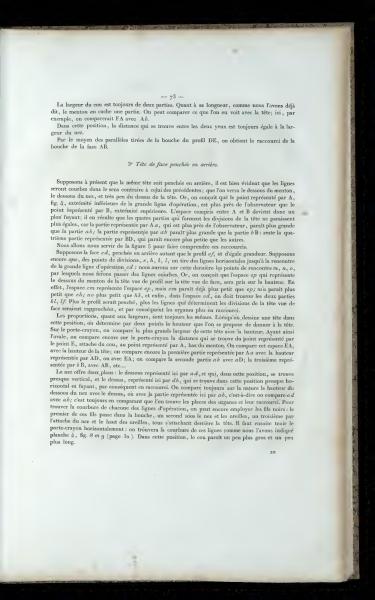Page 73
The width of the neck is always two parts. Regarding its length, as we have already mentioned, the chin hides one part. We can compare what is visible with the head; here, for example, we would compare FA with Ab.
In this position, the distance between the two eyes is always equal to the width of the nose.
Using the parallels drawn from the mouth in profile DE, we obtain the reduction of the mouth in face AB.
3° Head tilted backward.
Suppose now that the same head is tilted backward; it is evident that the lines will curve in the opposite direction from the previous ones; the underside of the chin, the underside of the nose, and very little of the top of the head will be visible. Thus, the point represented by A, fig. 4, the lower end of the main operational line, is closer to the observer than the point represented by B, the upper end. The space between A and B becomes a receding plane; thus, the four parts forming the divisions of the head no longer appear equal. The part represented by a A, which is closer to the observer, appears larger than the part ab; the part represented by ab appears larger than the part b B; the fourth part, represented by BD, appears even smaller than the others.
We will use figure 5 to explain these reductions.
Suppose the face, ci, is tilted backward as much as the profile ef, and equally tilted. Suppose also that the points of division, e, h, k, l, draw horizontal lines until meeting the main operational line, cd; on this last one, we will find the meeting points, m, n, o, through which we will draw curved lines. You can see that the space ep representing the underside of the chin from the profile view is represented when the head is seen from the front, taken on the height. In fact, cm space represents ep space, but cm already appears smaller than ep; mn smaller than pn; smaller than hk, and finally, in space od, you should find the two-thirds kl, l'. The more tilted the profile, the closer the lines determining the divisions of the head seen from the front, and consequently, the more foreshortened the features.
The proportions and marks are always the same. When drawing a head in this position, you determine the height you intend to give the head by two points. On the drawing tool, compare the greatest width of this head with the height. Having thus the point A, set on the cd, or the point represented by A, bottom of the chin. Compare this space EA with the height of the head; also compare the first part represented by Aa with the height represented by A B, or also EA; compare the second part ab with abD; the third part represented by b B, with AB, etc...
The nose offers two planes; the underside represented here by ad, which is almost vertical in this position, and the top, represented here by db, which is almost horizontal and receding in this position. Always compare the natural height of the underside of the nose with the top, compare di with the part represented here by ab, compare ad with ab; it's always by comparing that you find the position and foreshortening of the features. To find the curvature of each operational line, you can also use dark threads: the first passes through the mouth, a second under the nose and ears, a third passes by the nose's attachment and the top of the ears, all attached behind the head. You must then hold the drawing tool horizontally: you will find the curvature of these lines, as indicated in plate 4, fig. 8 and 9 (page 3a). In this position, the neck appears a bit wider and longer.
Page 20
This text explores the proportions and foreshortening of the head and face when viewed from different angles, such as the head tilted backward. It describes how the divisions of the head change when viewed from the front and discusses specific anatomical features like the neck, eyes, and nose positioning. Techniques for drawing these features using parallels, operational lines, and comparisons are also provided.
